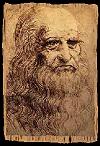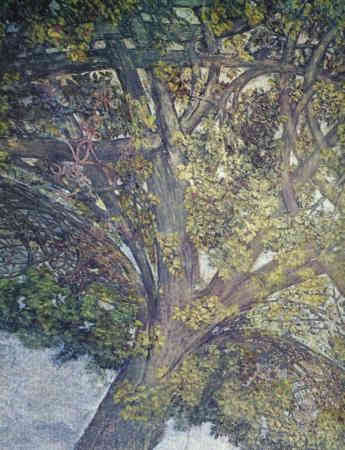|
Leonardo was responsible for the decoration of the ceiling and vault of the Sala delle Asse (translation: 'room of the tower' or 'room of the wooden boards') in Sforza's castle, Milan and although this cannot be considered a 'painting' in the usual sense of the word to not mention it would be unforgivable. He was presented with this room for his own use; access being gained via a bridge and arcade he had built over the moat.
Painted between 1495--1497, the fresco is made up of eighteen willow trees, two of which skillfully encircle two windows in the room . Where the boughs meet towards the ceiling they intertwine, thought to be a symbol of the marriage of Ludovico, Duke of Milan with Beatrice d'Este. Emblazoned throughout the branches is a fantastic golden rope made up of assorted loops and knots. Appearing to be several ropes, if it is followed the viewer discovers it is actually just the one cord which folds back on itself, twisting and turning throughout the entire pattern. Gold rope was a fashionable symbol of the day and appeared knotted on the clothing of Beatrice d'Este. Included in the work is the coat of arms of the Sforza family (falcons and serpents) which is painted in the very centre of the ceiling where the tree branches meet. Finally, four tablets were hung in the corners of the room to record important historic and political events of the day.
Much of the work on the 2,880 square foot canopy was carried out by Leonardo's pupils, but he did the design and this is a play on the word vinci, one meaning of which is willow. The search for any other hidden significance among the designs still continues, however it appears there is none to be found. The hall was then used as a barracks and the paint deteriorated and flaked away. In 1901 a restoration was begun by Luci Beltrami; just enough of the original paint remained for this to be successful, but the work done was so extensive that the fresco was largely remade and repainted. Beltrami completed the restoration by taking the few remaining traces of the original and repeating the designs and motifs until the entire vault was covered. Like the Last Supper, this is not the work Leonardo would have originally presented to the world. Further restoration went on in 1954 during which time a thorough cleaning of one small area was done and some boards removed which had been left untouched during the previous restoration; this revealed to some extent exactly how much the fresco had been altered by over painting. Originally the work was more open between the trees and branches, with the paint being less heavy, the leaves and branches more wavy. Large rocks were revealed through which roots were intertwined rising into huge tree trunks. Restorers of 1954 restrained themselves from completely removing all of the reconstruction done by Beltrami, restricting their own work to removing the heaviness evident in the new painting. With this they hoped the scene would achieve a more naturalistic look something Leonardo would have aimed for. |
|


